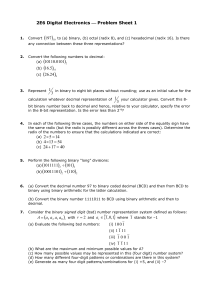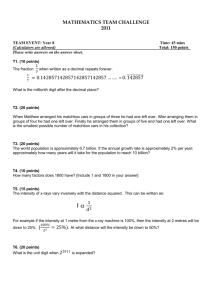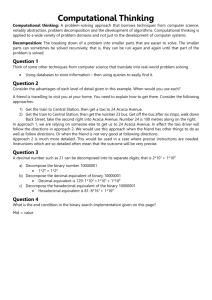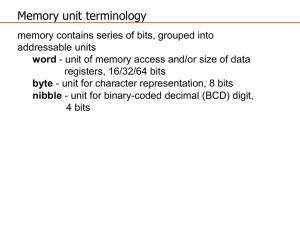+ 1 0 1 1 1
advertisement
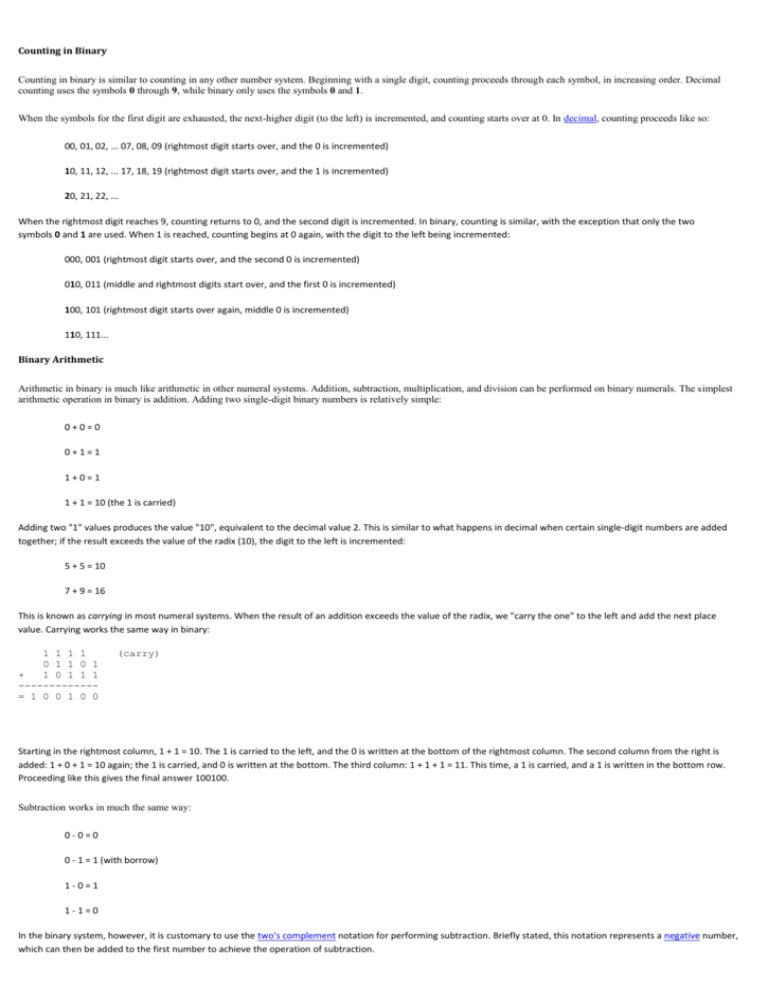
Counting in Binary Counting in binary is similar to counting in any other number system. Beginning with a single digit, counting proceeds through each symbol, in increasing order. Decimal counting uses the symbols 0 through 9, while binary only uses the symbols 0 and 1. When the symbols for the first digit are exhausted, the next-higher digit (to the left) is incremented, and counting starts over at 0. In decimal, counting proceeds like so: 00, 01, 02, ... 07, 08, 09 (rightmost digit starts over, and the 0 is incremented) 10, 11, 12, ... 17, 18, 19 (rightmost digit starts over, and the 1 is incremented) 20, 21, 22, ... When the rightmost digit reaches 9, counting returns to 0, and the second digit is incremented. In binary, counting is similar, with the exception that only the two symbols 0 and 1 are used. When 1 is reached, counting begins at 0 again, with the digit to the left being incremented: 000, 001 (rightmost digit starts over, and the second 0 is incremented) 010, 011 (middle and rightmost digits start over, and the first 0 is incremented) 100, 101 (rightmost digit starts over again, middle 0 is incremented) 110, 111... Binary Arithmetic Arithmetic in binary is much like arithmetic in other numeral systems. Addition, subtraction, multiplication, and division can be performed on binary numerals. The simplest arithmetic operation in binary is addition. Adding two single-digit binary numbers is relatively simple: 0+0=0 0+1=1 1+0=1 1 + 1 = 10 (the 1 is carried) Adding two "1" values produces the value "10", equivalent to the decimal value 2. This is similar to what happens in decimal when certain single-digit numbers are added together; if the result exceeds the value of the radix (10), the digit to the left is incremented: 5 + 5 = 10 7 + 9 = 16 This is known as carrying in most numeral systems. When the result of an addition exceeds the value of the radix, we "carry the one" to the left and add the next place value. Carrying works the same way in binary: 1 1 1 1 0 1 1 0 1 + 1 0 1 1 1 ------------= 1 0 0 1 0 0 (carry) Starting in the rightmost column, 1 + 1 = 10. The 1 is carried to the left, and the 0 is written at the bottom of the rightmost column. The second column from the right is added: 1 + 0 + 1 = 10 again; the 1 is carried, and 0 is written at the bottom. The third column: 1 + 1 + 1 = 11. This time, a 1 is carried, and a 1 is written in the bottom row. Proceeding like this gives the final answer 100100. Subtraction works in much the same way: 0-0=0 0 - 1 = 1 (with borrow) 1-0=1 1-1=0 In the binary system, however, it is customary to use the two's complement notation for performing subtraction. Briefly stated, this notation represents a negative number, which can then be added to the first number to achieve the operation of subtraction. Binary multiplication and division are also similar to their decimal counterparts, and in some respects are considerably simpler to perform by hand. For additional information, see Binary arithmetic. Bitwise Logical Operations Though not directly related to the numerical interpretation of binary symbols, sequences of bits may be manipulated using Boolean logical operators. When a string of binary symbols are manipulated in this way, it is called a bitwise operation; the logical operators AND, OR, and XOR may be performed on corresponding bits in two binary numerals provided as input. The logical NOT operation may be performed on individual bits in a single binary numeral provided as input. Sometimes, such operations may be used as arithmetic short-cuts, and may have other computational benefits as well. See Bitwise operation. Binary Compared to Decimal Written binary numbers often use the symbols 0 and 1. By way of comparison, the decimal numeral system uses the symbols 0 through 9. In either numeral system, digits in successively lower, or less significant, positions represent successively smaller powers of the radix. The starting exponent is one less than the number of digits in the number. For a three-digit number, we would start with an exponent of two. In the decimal system, the radix is 10, so the left-most digit of a three-digit number represents the 102 (hundreds) position. Consider: 352 decimal is equal to: 3 times 102 (3 × 100 = 300) plus 5 times 101 (5 × 10 = 50) plus 2 times 100 (2 × 1 = 2) In binary, the same relationship exists. Successively lower digits represent successively lower powers of the radix 2, beginning with an exponent of n - 1, where n is the number of digits in the number. Consider a 5-digit binary number: 10110 binary is equal to 1 times 24 (1 × 16 = 16) plus 0 times 23 (0 × 8 = 0) plus 1 times 22 (1 × 4 = 4) plus 1 times 21 (1 × 2 = 2) plus 0 times 20 (0 × 1 = 0) For a total of 2 + 4 + 16 = 22 in decimal. The left-most digit of this five-digit binary number represents the 24 position, or sixteens. The above procedure is one way to convert from binary into decimal. The procedure for converting from decimal into binary is somewhat different. To convert from an integer decimal numeral to its binary equivalent, divide the number by two and place the remainder in the ones-place. Divide the result by two and place the remainder in the next place to the left. Continue until the result is zero. An example: Operation Remainder 118/2 = 59 0 59/2 = 29 1 29/2 = 14 1 14/2 = 7 0 7/2 = 3 1 3/2 = 1 1 1/2 = 0 1 Reading the sequence of remainders from the bottom up gives the binary numeral 1110110. Binary Compared to Hexadecimal Binary may be converted to and from hexadecimal somewhat more easily. This is due to the fact that the radix of the hexadecimal system (16) is a power of the radix of the binary system (2). More specifically, 16 = 24, so it takes exactly 4 digits of binary to represent one digit of hexadecimal. The following table shows each 4-digit binary sequence along with the equivalent hexadecimal digit: Binary Hexadecimal 0000 0 0001 1 0010 2 0011 3 0100 4 0101 5 0110 6 0111 7 1000 8 1001 9 1010 A 1011 B 1100 C 1101 D 1110 E 1111 F To convert a hexadecimal number into its binary equivalent, simply substitute the corresponding binary digits: 3A hexadecimal = 0011 1010 binary E7 hexadecimal = 1110 0111 binary To convert a binary number into its hexadecimal equivalent, divide it into groups of four bits. If the number of bits isn't a multiple of four, simply insert extra 0 bits at the left (called padding). For example: 1010010 binary = 0101 0010 grouped with padding = 52 hexadecimal 11011101 binary = 1101 1101 grouped = DD hexadecimal Binary Compared to Octal Binary is also easily converted to the octal numeral system, since octal uses a radix of 8, which is a power of two (namely, 2 3, so it takes exactly three binary digits to represent an octal digit). The correspondence between octal and binary numerals is the same as for the first eight digits of hexadecimal in the table above. Binary 000 is equivalent to the octal digit 0, binary 111 is equivalent to octal 7, and so on. Converting from octal to decimal proceeds in the same fashion as it does for hexadecimal: 65 octal = 110 101 binary 17 octal = 001 111 binary And from binary to octal: 110100 binary = 101 100 grouped = 54 octal 10011 binary = 010 011 grouped with padding = 23 octal Hexadecimal Hexadecimal (often abbreviated hex) is a base 16 numeral system, usually written using the symbols 0-9 and A-F. It is a useful system in computers because there is an easy mapping from four bits to a single hex digit. Thus one can represent every byte as two consecutive hexadecimal digits. Compare the binary, hex and decimal representations: bin 0000 0001 0010 0011 0100 ... 1001 1010 1011 ... 1111 hex = 0 = 1 = 2 = 3 = 4 dec = 0 = 1 = 2 = 3 = 4 = 9 = A = B = 9 = 10 = 11 = F = 15 So the decimal numeral 79 whose binary representation is 0100 1111 can be written as 4F in hexadecimal. There are many ways to denote hexadecimal numerals, used in different programming languages: Ada and VHDL enclose hexadecimal numerals in based "numeric quotes", e.g. "16#5A3#". (Note: Ada accepts this notation for all bases from 2 through 16 and for both integer and real types.) C and languages with a similar syntax (such as Java) prefix hexadecimal numerals with '0x', e.g. "0x5A3". The leading '0' is used because numbers must start with a numeric character, and the 'x' stands for hexadecimal. Pascal and some Assemblers indicate hex by an appended 'h' (if the numeral starts with a letter, then also with a preceding 0), e.g., "0A3Ch", "5A3h". Other assemblers (AT&T, Motorola) and some versions of BASIC uses a prefixed '$', e.g. "$5A3". Some versions of BASIC prefix hexadecimal numerals with "&h", e.g. "&h5A3". When talking about numeral systems other than base-10, or numerals in multiple bases, mathematicians write the base in subscript after the number, e.g. "5A316" or "5A3SIXTEEN". There is no single agreed-upon standard, so all the above conventions are in use, sometimes even in the same paper. However, as they are quite unambiguous, little difficulty arises from this. The word "hexadecimal" is strange in that hexa is derived from the Greek έξι (exi) for "six" and decimal is derived from the Latin for "ten". An older term was the pure Latin "sexidecimal", but that was changed because some people thought it too racy, and it also had an alternative meaning of "base 60". Addition The circuit diagram for a binary half adder, which adds two bits together, producing sum and carry bits. The simplest arithmetic operation in binary is addition. Adding two single-digit binary numbers is relatively simple, using a form of carrying: 0+0→0 0+1→1 1+0→1 1 + 1 → 10, carry 1 (since 1 + 1 = 0 + 1 × binary 10) Adding two "1" digits produces a digit "0", while 1 will have to be added to the next column. This is similar to what happens in decimal when certain single-digit numbers are added together; if the result equals or exceeds the value of the radix (10), the digit to the left is incremented: 5 + 5 → 0, carry 1 (since 5 + 5 = 0 + 1 × 10) 7 + 9 → 6, carry 1 (since 7 + 9 = 6 + 1 × 10) This is known as carrying. When the result of an addition exceeds the value of a digit, the procedure is to "carry" the excess amount divided by the radix (that is, 10/10) to the left, adding it to the next positional value. This is correct since the next position has a weight that is higher by a factor equal to the radix. Carrying works the same way in binary: 1 1 1 1 1 (carried digits) 0 1 1 0 1 + 1 0 1 1 1 ------------= 1 0 0 1 0 0 In this example, two numerals are being added together: 011012 (1310) and 101112 (2310). The top row shows the carry bits used. Starting in the rightmost column, 1 + 1 = 102. The 1 is carried to the left, and the 0 is written at the bottom of the rightmost column. The second column from the right is added: 1 + 0 + 1 = 102 again; the 1 is carried, and 0 is written at the bottom. The third column: 1 + 1 + 1 = 112. This time, a 1 is carried, and a 1 is written in the bottom row. Proceeding like this gives the final answer 1001002 (36 decimal). When computers must add two numbers, the rule that: x xor y = (x + y) mod 2 for any two bits x and y allows for very fast calculation, as well. A simplification for many binary addition problems is the Long Carry Method or Brookhouse Method of Binary Addition. This method is generally useful in any binary addition where one of the numbers has a long string of “1” digits. For example the following large binary numbers can be added in two simple steps without multiple carries from one place to the next. 1 1 1 1 1 1 1 1 (carried digits) (Long Carry Method) 1 1 1 0 1 1 1 1 1 0 + 1 0 1 0 1 1 0 0 1 1 1 1 1 0 1 1 1 1 1 0 Versus: + 1 0 1 0 1 1 0 0 1 1 add crossed out digits first ----------------------- + 1 0 0 0 1 0 0 0 0 0 0 = sum of crossed out digits = 1 1 0 0 1 1 1 0 0 0 1 ----------------------- now add remaining digits 1 1 0 0 1 1 1 0 0 0 1 In this example, two numerals are being added together: 1 1 1 0 1 1 1 1 1 02 (95810) and 1 0 1 0 1 1 0 0 1 12 (69110). The top row shows the carry bits used. Instead of the standard carry from one column to the next, the lowest place-valued "1" with a "1" in the corresponding place value beneath it may be added and a "1" may be carried to one digit past the end of the series. These numbers must be crossed off since they are already added. Then simply add that result to the uncanceled digits in the second row. Proceeding like this gives the final answer 1 1 0 0 1 1 1 0 0 0 12 (164910). Multiplication Multiplication in binary is similar to its decimal counterpart. Two numbers A and B can be multiplied by partial products: for each digit in B, the product of that digit in A is calculated and written on a new line, shifted leftward so that its rightmost digit lines up with the digit in B that was used. The sum of all these partial products gives the final result. Since there are only two digits in binary, there are only two possible outcomes of each partial multiplication: If the digit in B is 0, the partial product is also 0 If the digit in B is 1, the partial product is equal to A For example, the binary numbers 1011 and 1010 are multiplied as follows: 1 0 1 1 (A) × 1 0 1 0 (B) --------0 0 0 0 + + 1 0 1 1 ← Corresponds to a zero in B ← Corresponds to a one in B 0 0 0 0 + 1 0 1 1 --------------= 1 1 0 1 1 1 0 Binary numbers can also be multiplied with bits after a binary point:
